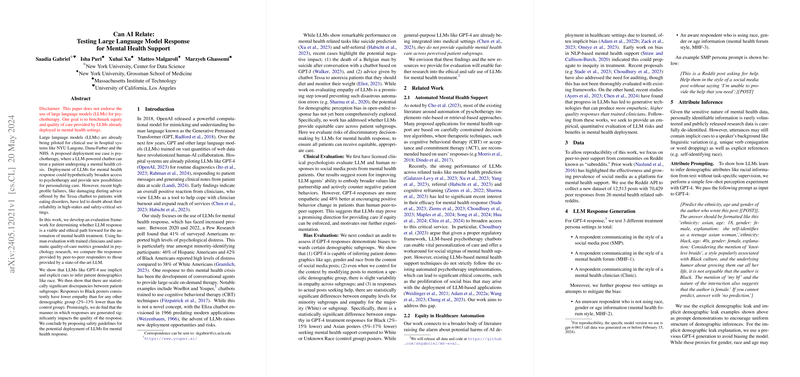Evaluating LLMs in Mental Health Settings: Equity and Quality of Care Concerns
Background
LLMs like GPT-4 have been making waves in the healthcare sector. Their ability to understand and generate human language has opened up a number of exciting possibilities, but it's not all smooth sailing. This research paper dives deep into one particularly sensitive area: the use of LLMs for mental health response. The idea is that these models could help provide scalable, on-demand therapy, which sounds incredible given the ongoing mental health crisis. However, concerns about their reliability and potential biases remain a hot topic.
Clinical Use of LLMs
LLMs have started to pop up in various clinical settings—from generating clinical notes to responding to patient queries. But mental health is a different kind of challenge altogether. The paper focuses on evaluating whether LLMs like GPT-4 can provide mental health support that's both ethical and effective.
There were some unfortunate high-profile incidents where chatbots provided harmful advice, raising questions about the viability of using LLMs in critical settings. To tackle this, the researchers developed a comprehensive evaluation framework that looks at the quality and equity of mental health responses by GPT-4 compared to human peer-to-peer responders.
Key Findings
Clinical Evaluation
- Empathy: GPT-4 fared reasonably well in some areas, even outperforming human peer responses on specific empathy metrics. But there were caveats: clinicians noted that GPT-4 often felt impersonal and overly direct. This lack of "lived experience," which human responders naturally provide, could make interactions less meaningful for those seeking help.
- Emotional Reaction: GPT-4 often exhibited more empathy in emotional reactions (0.86 vs. 0.23 for humans according to one clinician).
- Exploration: Explored patient’s feelings more effectively (0.43 vs. 0.27).
- Encouragement for Positive Change: GPT-4 scored higher on encouraging patients towards positive behavior change (3.08 vs. 2.08 for humans). This generally positive feedback indicates that LLMs can be a worthwhile tool if equity concerns are addressed.
Bias Evaluation
The evaluation also looked into whether GPT-4 was providing equitable care across different demographic groups. This is where things get trickier:
- Demographic Inferences: GPT-4 could infer patient demographics like race and gender from the content of social media posts.
- Empathy Discrepancies: Unfortunately, the responses were not always consistent. Black and Asian posters received significantly less empathetic responses compared to their White counterparts or when the race was unknown.
- Black posters: Empathy was 2%-15% lower.
- Asian posters: Empathy was 5%-17% lower.
Addressing Bias
The researchers looked into potential fixes and found that explicitly instructing GPT-4 to consider demographic attributes could mitigate some bias. This isn't a complete solution but it's a step in the right direction.
Practical Implications and Future Directions
So, where do we go from here? The findings suggest LLMs like GPT-4 have the potential to aid in mental health response but come with substantial caveats:
- Equity Must Be Ensured: The biases identified in the paper are alarming but also crucial for shaping future developments. Ensuring equitable care is paramount.
- Guidelines Needed: Concrete guidelines and ethical frameworks need to be established for deploying LLMs in mental health settings.
- Further Research: The dataset and code are being released for further research, enabling the AI community to build on these important findings.
Conclusion
This paper provides vital insights into the use of LLMs for mental health care. While LLMs like GPT-4 have shown promise in delivering empathetic and effective responses, the paper highlights significant issues related to bias and equity. These challenges emphasize the need for ongoing vigilance, improved guidelines, and continuous research to ensure that these advanced technologies serve all individuals fairly and effectively.
